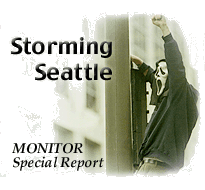
Troops Move Into Position
by Paul de Armond
 |
by Paul de Armond |
|
At
5AM Tuesday morning, Washington State Patrol Chief Annette Sandberg had coffee at the Starbucks near the Convention Center. Nobody would be having coffee there that evening, as it would be smashed and looted. Sandberg saw demonstrators moving into strategic positions before any police had arrived. The converging columns of the Direct Action Network began to shut down Seattle.
The first Direct Action Network "arrest" affinity groups moved in on the strategic intersections in the vicinity of the Convention Center. Afterwards, these protesters said that they were surprised by the absence of any police presence on the streets. In many locations, the "arrest" groups arrived earlier than the "non-arrest" groups which were supposed to protect them from removal by the police. The news photographs of these initial "lock-down" groups have a surrealistic air to them. In the empty streets after dawn, groups of protesters lock themselves together with bicycle locks or tubes covering their linked arms to prevent police from removing them individually. King County Sheriff Dave Reichert says he got a telephone call at 8AM from a county detective. "He said, 'Sheriff, we're trapped... We have no backup,' " Reichert claimed. "I had officers barricaded in the hotel with a mob literally pounding on the glass, and there was nobody to help them. Nobody." Reichert wasn't on the scene, but already he was seeing "mobs." KIRO-7 television crews were at the same location and show lines of grinning demonstrators holding hands and blocking the street -- no "mob literally pounding on the glass." Sheriff Reichert was the first self-inflicted casualty of the intelligence failure. In the blamestorm of controversy which erupted after the protests, Reichert was the head cheerleader among the hardliners who condemned the Seattle Police's "lack of preparedness." The Seattle Police were prepared for non-violent demonstrations and their only failure of strategic intelligence was misjudging the size of the crowds. Nobody could be prepared for the fantatsies of the FBI and the Sheriff. There were no "terrorists" behind the demonstrations, no "mobs," no "violent protesters." The police need to fantasize violence on the part of the protesters was a projection of their own desire for violence. This fundamental disconnect between reality and fantasy continually crippled the police strategy and rendered it ineffective.
|
|
The
Direct Action Network planned more effectively, and in the end more realistically, with a "Peoples Convergence" consisting of three waves of blockaders enclosing the WTO conference site:
The direct point of contact between the Direct Action Network and the WTO was the Seattle Police Department (SPD). Under the leadership of Chief Norm Stamper, the SPD has become a national laboratory for a progressive philosophy of law enforcement known as "community policing." Recently, the relations between the police and Mayor Schell's administration have not been good. One of the outcomes of Chief Stamper's community policing initiative has been the formation of a police accountability organization which reports separately to the Chief and the City Council through two separate boards. The road to community policing has been rocky, particularly in light of the resistance from rank and file cops. Add to that the heightened tensions because of contract negotiations between the City and the police union. The total size of the Seattle Police Department is roughly 1,800 officers, of whom about 850 are available for street duty throughout the city. Of these, 400 were assigned to the WTO demonstrations. Seattle has about the same ratio of police to population as Chicago, but Seattle's smaller size limited in the number of officers it could field against the protesters -- unless, of course, the SPD entered into some sort of joint WTO operation with other police agencies in the region. By Wednesday, the second day of the protests, more than 500 state and regional police, plus some 200 National Guard would be deployed. The largest two outside police forces available to Seattle are the King County Sheriff's department and the Washington State Patrol. Sheriff Dave Reichert is a conservative Republican and political foe of Mayor Schell. This reflects the long-standing division between Seattle and the King County government. The suburban fringe surrounding Seattle is the traditional political battleground in which statewide elections are fought, with the outlying areas going to the Republicans, the heavily urbanized areas going to the Democrats and the suburbs swinging back and forth between the two. The State Patrol chief is responsible to Gov. Gary Locke, a nominal Democrat who rose to the governorship through the King County Council. The governor also controls the National Guard, although these forces can't be committed to street action without the declaration of a state of emergency by the governor and the request of the mayor. Neither the King County police nor the State Patrol are supporters of community policing policies, which meant that outside assistance would entail Chief Stamper presiding over a joint command divided by fundamental policy differences. Mayor Schell decided that he and Chief Stamper would deal with the demonstrations without the direct support of other law enforcement agencies. Most critics have claimed that this decision was the reason the protests succeeded. There are strong reasons to believe that this is not so, and that the Tuesday protests would have succeeded in attaining their goals (though in a less spectacular fashion) even if the police presence had included the outside agencies. One of the considerations which weighed against the employment of outside police was the strong possibility that they would attack city residents, as indeed happened on Wednesday night.
Albion Monitor
February 29, 2000 (http://www.monitor.net/monitor) All Rights Reserved. Contact rights@monitor.net for permission to use in any format. | ||||||||||